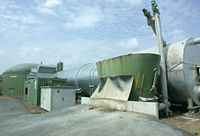
Photo from wikipedia
The hydrolysis of carbonaceous and nitrogenous materials in the anaerobic co-digestion process of solid vegetable waste and anaerobic sewage sludge (ASS) was studied from the perspective of zero-, first-, and… Click to show full abstract
The hydrolysis of carbonaceous and nitrogenous materials in the anaerobic co-digestion process of solid vegetable waste and anaerobic sewage sludge (ASS) was studied from the perspective of zero-, first-, and second-order pseudo-kinetic models. It was found that the digestion of the chemical demand for particulate oxygen (CODP) and subsequent conversion to the filtered form (CODF) occurs in two stages of digestion, with significant differences between the kinetic constants of hydrolysis (kh) and half-life (t1/2). A simplified kinetic model based on the first-order differential equation was proposed to model the conversion rate between CODP and CODF, resulting in excellent calibration parameters (R-sqr> 0.99, Fcalc >> Ftable) and validation parameters (R-sqr = 0.99, intercept 0.001, and bisector 0.98). It was also observed that the formation of volatile fatty acids (VFA) and organic nitrogen ( N.org ) occurs in two kinetic stages, one rapid and the other slow, which coincide with those described for CODF. However, the decay of total nitrogen levels (TKN) occurs in a single step. Despite the mathematical simplicity, the kinetic models addressed in this study presented validation parameters suitable in statistical terms, both in the modeling tests and in the prediction tests, opening new possibilities in the environment of biodigestion process modeling.
Journal Title: Biomass Conversion and Biorefinery
Year Published: 2021
Link to full text (if available)
Share on Social Media: Sign Up to like & get
recommendations!